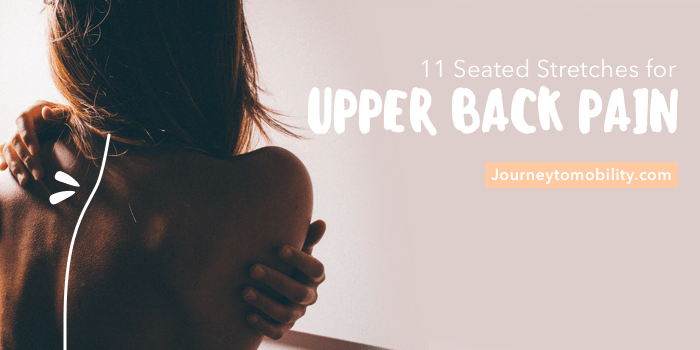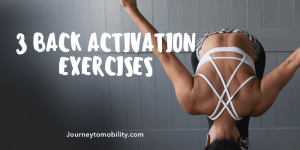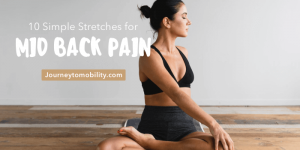We are often unaware that the things we do everyday (without much thought) could increase our risk of developing upper back pain later on in our lives. Back and neck pain are often caused by lifestyle factors such as our posture, how we sit, stand, move and lift objects. When we do these activities incorrectly, we put a lot of stress on our spine which results in muscle and joint pain.
Common Causes of Upper Back Pain
- Prolonged standing or sitting
- Poor posture
- Lifting improperly
- Sports injury
Our muscles work together with other muscles in the body to allow us to move. It’s an incredible system. For every movement that we make, some muscles contract while others extend. Thus, tightness in one muscle group will likely affect the muscles next to it. On the other hand, pain in one area could also be caused by muscle tightness in surrounding areas.
It isn’t always easy to pinpoint where the problem is. Instead, we can target problem areas by stretching them in different ways to effectively reduce pain.
11 Seated Stretches for Upper Back Pain
Here are some easy stretches for upper back and neck pain that you can do right at your desk! Hold each stretch for 10-20 seconds on both sides. Repeat each stretch for 2-3 repetitions.
1) Seated Cat Cow Stretch
Seated variation of the Cat Cow pose in yoga. Extending and contracting your back helps to ‘reset’ the spine from being in one position throughout the day.
- Inhale as you arch your back. Draw your shoulders behind your ears and bring your chest up.
- Exhale as you reverse the movement, creating a “C” shape with your body. Tuck your chin into your chest and round your shoulders. (If you forget where you should be taking a breath, just remember to exhale when your abs contract).
- Repeat for 5-10 breath cycles, or whatever feels good for your body.
2) Half Hang Stretch
Prolonged sitting or standing, often limits movement in the thoracic spine. This leads to tightness in the chest and lats. The Half Hang stretch helps to loosen up these areas by activating the upper back muscles down through to the lats.
- Extend your arms, palms down on a desk in front of you. Inhale.
- Exhale as you flatten your back and pull your head through your arms.
- Hold for 10-20 seconds. Repeat 2-3 times.
3) Desk Lean with Elbows
This is a variation of the Half Hang Stretch. You should feel this stretch a bit more in your upper back.
- Place your elbows on a desk in front of you with your hands clasped. Inhale.
- Exhale as you pull your head through your arms.
- Lift your shoulder blades on each inhale.
- Press your elbows down and through as you exhale to intensify the stretch.
- Hold for 10-20 seconds. Repeat 2-3 times.
4) Shoulder Shrugs
This exercise helps to stabilize and release tension in your upper back and neck muscles. Focus on drawing large circles with your shoulders as you rotate forwards and backwards.
- Roll your shoulders forwards 5 times.
- Roll your shoulders backwards 5 times. Allow your elbows to move freely.
5) Twisted Lift
This stretch opens up the shoulder blades through the flexion of your upper back muscles (rounding out your back to create a “C” shape).
- Cross your arms and grab your thighs.
- Curve your back into a “C” shape with your chin tucked in. Imagine that there is a string pulling your back towards the ceiling.
- Take deep breaths as you actively lift the mid part of your back.
- Hold for 10-20 seconds. Repeat 2-3 times.
6) Twisted Side Stretch for Upper Back Pain
Add in a twist as you lift upwards helps with lateral flexion by targeting your sides.
- Cross your arms and grab your thighs. One arm should be over the other.
- Curve your back into a “C” Shape with your chin tucked in.
- Notice the arm on top. Lean your body in the direction of the top arm.
- Cross your other arm on top and lean in the direction of the top arm.
- Hold for 10-20 seconds. Repeat 2-3 times.
7) Reach Behind Back Stretch
This stretch helps to improve shoulder mobility and extension as well as opening up your chest
- Open up your chest (shoulders away from the ears).
- Reach both arms behind you and clasp your hands together.
- Engage your arms and lift up towards the ceiling. Lift with each exhale.
- Hold for 10-20 seconds. Repeat 2-3 times.
8) Thoracic Extension Over the Chair for Upper Back Pain
The thoracic spine is built for rotation, flexion, and extension. When we sit for long hours, our back is in a state of excessive flexion (shoulders rounded forward). Overtime, we lose the ability to engage in extension. This stretch supports the lower back to allow you to target the muscles in the mid-back.
- Place your hands behind your head with your elbows wide.
- Lend back over the chair. The chair should secure your mid back in place to allow you to stretch the upper part of your spine.
- Keep your chest open, face your head towards the ceiling.
- Hold for 10-20 seconds. Repeat 2-3 times.
9) Seated Spinal Twist for Upper Back Pain
The muscles and other tissues that surround the spine can become stiff from sitting for long periods of time. This will lead to a decreased range of motion, pain and discomfort. Practicing twisting postures helps to keep the spinal muscles mobile.
- With one arm, grab behind you to the opposite side of the chair (you can hold on to the chair seat or the back of the chair).
- The other arm should reach in the same direction and grab the side of the chair by your hip.
- Breathe in and twist your body as you breathe out.
- Hold for 10-20 seconds. Repeat 2-3 times.
10) Push Elbow Back
This stretch helps with shoulder mobility. You will feel a gentle stretch across the under part of your arm to the shoulder cap.
- Reach your hand over to the opposite shoulder.
- Use your other hand to push your elbow inwards and up.
- Gently, press the shoulder blade outwards.
- Hold for 10-20 seconds. Repeat 2-3 times on both sides.
11) Tricep with Side Stretch
Side stretches help to open up the lateral muscles in your upper body. You should feel this stretch in your triceps all the way down to your torso.
- Reach one arm over your head to the opposite back.
- Pull the elbow with your other hand as you lean to the side for a stretch.
- Keep your chest open and head facing the ceiling.
- Inhale and lower down into the stretch as you exhale to deepen the stretch.
- Hold for 10-20 seconds. Repeat 2-3 times on both sides.
Conclusion
Perform a few simple stretches each day will help treat your back pain and avoid pain in the future. Our muscles shorten and lose their elasticity as we age. When we move our spines in different ways, our muscles become weak which causes pain. By stretching our back, chest, shoulders, triceps and muscles in the upper body, we can relieve upper back pain, improve posture and range of motion.
Stretching out the hamstrings also helps with pain in the upper back, click here to read more and download a free routine.




